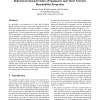Free Online Productivity Tools
i2Speak
i2Symbol
i2OCR
iTex2Img
iWeb2Print
iWeb2Shot
i2Type
iPdf2Split
iPdf2Merge
i2Bopomofo
i2Arabic
i2Style
i2Image
i2PDF
iLatex2Rtf
Sci2ools
ICC
2007
IEEE
2007
IEEE
Behavioral Characteristics of Spammers and Their Network Reachability Properties
By analyzing a two-month trace of more than 25 million emails received at a large US university campus network, of which more than 18 million are spam messages, we characterize the spammer behavior at both the mail server and the network levels. We also correlate the arrivals of spam with the BGP route updates to study the network reachability properties of spammers. Among others, our significant findings are: (a) the majority of spammers (93% spam only mail servers and 58% spam only networks) send only a small number of spam messages (no more than 10); (b) the vast majority of both spam
Related Content
| Added | 02 Jun 2010 |
| Updated | 02 Jun 2010 |
| Type | Conference |
| Year | 2007 |
| Where | ICC |
| Authors | Zhenhai Duan, Kartik Gopalan, Xin Yuan |
Comments (0)

